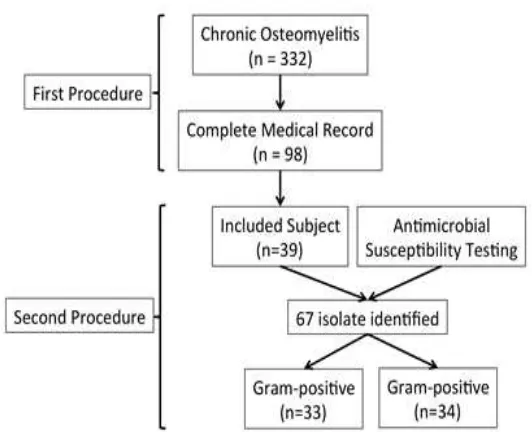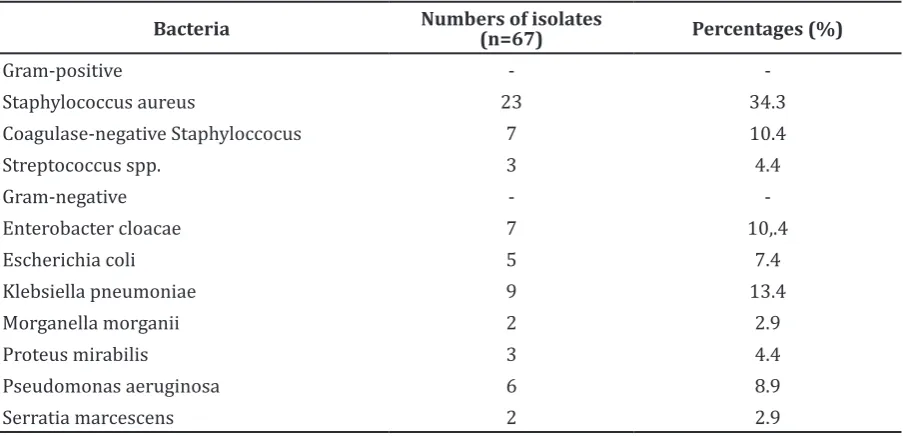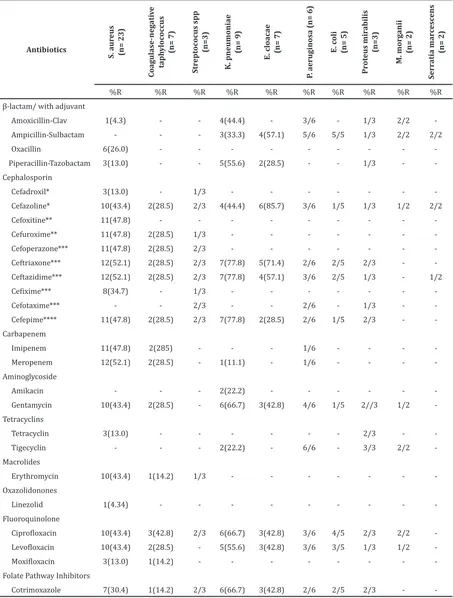Bacterial Resistance Pattern to Cephalosporin in Patient with Chronic
Osteomyelitis at Dr. Hasan Sadikin General Hospital Bandung
Daniel Christian Fernandez,1 Ghuna Arioharjo Utoyo,2 Adhi Kristianto Suganli3
1Faculty of Medicine Universitas Padjadjaran, 2Department of Orthopaedic and Traumatology
Faculty of Medicine Universitas Padjadjaran/Dr. Hasan Sadikin General Hospital Bandung,
3Department of Clinical Pathology Faculty of Medicine Universitas Padjadjaran/Dr. Hasan Sadikin
General Hospital Bandung
Abstract
Background: Chronic osteomyelitis remains difficult to treat and has a high rate of relapse after apparently
succesful treatment. Cephalosporin has been greatly used for the antibiotic intervention for patient with
osteomyelitis. The objective of this study was to explore bacterial profile and its microbial resistance pattern
of each generation of cephalosporin from patients with chronic osteomyelitis at Dr. Hasan Sadikin General Hospital.
Methods: A descriptive study was conducted to 39 medical records from patients with chronic osteomyelitis at Dr. Hasan Sadikin General Hospital that met both inclusion and exclusion criteria. The bacterial pattern and antimicrobial susceptibility test results were obtained from both medical record and laboratory
database for five years, during the period of Januari 2009 to December 2014. Data of bacterial species, type
of Gram staining, and numbers of resistance isolates to antiobiotic were taken from the collected data and analyzed in form of frequency tabulation and percentages.
Results: As high as 43−52% of Staphylococcus aureus isolates were resistant to all generation of cephalosporin. Coagulase-negative Staphylococci and Streptococcus spp. showed resistance to cephalosporin
as high as 29% and 67%, respectively. This study also discovered that 5 of 23 Staphylococcus aureus isolates
were methicillin-resistant Staphylococcus aureus (MRSA). Klebsiella pneumoniae showed a leading number
of resistance pattern for both third and fourth generation of cephalosporin (77%). Enterobacter cloacae
showed highly resistance for both first and third generation of cephalosporin, between 57−86%.
Conclusions: There is the high resistance of all bacteria to cephalosporin among chronic osteomyelitis patients. [AMJ.2016;3(3):376–81]
Keywords: Antimicrobial resistance, cephalosporin, chronic osteomyelitis
Correspondence: Daniel Christian Fernandez, Faculty of Medicine, Universitas Padjadjaran, Jalan Raya Bandung-Sumedang Km.21,
Jatinangor, Sumedang, Indonesia, Phone: +6285276077912 Email: danielchristianfernandez@gmail.com
Introduction
Chronic osteomyelitis is one of the most challenging and expensive diseases to treat, despite advances in antibiotics and new operative intervention techniques.1 Specific diagnostic strategies are ill-defined and lack of prospective evidence. It is difficult to detect
the acute phase symptoms of osteomyelitis, therefore, it is more likely to treat the patient when the disease progresses to the chronic phase.2 The gold standard to establish a
diagnosis remains by a bone culture, but
false-negative rates are reported as high as 40%.3
The invasive procedure has to be conducted to take the sample for microbial culture, and it is more likely having a delay since it is commonly taken during surgical procedure e.g adjacent tissue reconstruction, drainage,
and repair. As the result, the patient is given an empiric antibiotic treatment before knowing the etiological agent for the disease. Studies showed that patient receiving antibiotic regimen without bone culture-guidance is more likely to have worst outcome than those with any bone culture-guided antibiotic regimen.4
In the antibiotic era, chronic osteomyelitis
remains difficult to treat and has a high rate of
relapse after apparently succesful treatment.1,3
Since it has the same characteristic as penicillin for antimicrobial treatment in osteomyelitis, cephalosporin has been greatly used for the antibiotic intervention to kill bacteria that infect the patient with osteomyelitis.5,6 Klebsiella pneumoniae, as one of the etiological agents of chronic osteomyelitis,
was reported to be resistant as high as 44%
United States, patients with the infection due to antibacterial-resistance organism, has a higher cost of treatment compared to patients with antibacterial-susceptible organism.8 The increase of bacterial resistance gives a great
influence on mortality rate, substantial cost
of the treatment, and the length of stay in hospital.9,10
The objective of this study was to explore
bacterial profile and its microbial resistance
pattern of each generation of cephalosporin from patients with chronic osteomyelitis at Dr. Hasan Sadikin General Hospital, Bandung, Indonesia.
Methods
The descriptive design was chosen to accomplish this study that was performed at Dr. Hasan Sadikin General Hospital. The population of the study was taken from all patients’ medical records which had been diagnosed as having osteomyelitis and
admitted to hospital for five years during the period of Januari 2009 to December 2014.
The inclusion criterion of this study was all patient medical records admitted to Dr. Hasan
Sadikin General Hospital for the first time and
diagnosed to have chronic ostemyelitis, either
as primary diagnosis or additional diagnosis. The exclusion criteria of this study were chronic osteomyelitis patients without complete nor available antimicrobial susceptibility testing result. The data collection process was divided
into two procedures.The first procedure was
gathering all the primary information about
patient’s demographic profile with chronic osteomyelitis. The first procedure was taken
from digital medical record database with disease group categories: chronic osteomyelitis
(diagnosis code: M86.6), according to International Classification of Diseases (ICD)
10. After getting the lists of patient and medical record number, full set hard copies of each patient’s medical record was taken and evaluated for inclusion criteria. The second
procedure was matching the first admission
of patient with the date of the sample sent to laboratory for antimicrobial susceptibility testing from laboratory database system.
From Januari 2009 to December 2014, there
were 332 patients with chronic osteomyelitis who had been admitted to Dr. Hasan Sadikin General Hospital. Among them, there were
only 98 patients with chronic osteomyelitis, which had complete medical record. From 98
patients with complete medical record, there were only 39 patients who had antimicrobial
susceptibility testing result, in concordance
with first admission of patient. There were 67 bacteria identified from the 39 patients with
chronic osteomyelitis (Figure 1).
Data of bacterial species, types of Gram staining, numbers of resistance isolates to antiobiotic were taken and analyzed in form of frequency tabulation and percentages. This study was conducted with the ethical standard approval from both Faculty of Medicine Universitas Padjadjaran and Dr. Hasan Sadikin General Hospital, with ethical letter No.
LB.04.01/A05/EC/312/VII/2015.
Results
The distribution of bacteria isolated from chronic osteomyelitis was described in Table 1. In this study, the most Gram-positive bacteria isolated were Staphylococcus aureus and the most Gram-negative bacteria isolated were Klebsiella pneumoniae.
Table 2 shows the number of bacteria as the etiology of chronic osteomyelitis with the antimicrobial susceptibility testing. Based on the result, almost all bacteria were resistant to cephalosporin group. Cephazoline, as a
part of first generation of cephalosporin,
had a high range of resistance pattern for both Gram-positive and Gram-negative
bacteria, with a value between 29−86%. As high as 86% of Enterobacter cloacae were resistant to cephazoline and had the highest resistance pattern compared to any bacteria
to the first generation of cephalosporin.
Cefadroxil, which was tested only to Gram-positive bacteria, had a range of resistance
between 13−33%. Meanwhile, the second
generation of cephalosporintested only for the Gram-positive bacteria, showed both cefoxitin and cefuroximehave resistance value
of aprroximately 48% and between 29−48%
respectively.
In third generation of cephalosporin, there were ceftriaxone, ceftazidime, and cefotaxime that were tested for both Gram-positive and Gram-negative bacteria. Ceftriaxone had a high pattern of resistance, with a value range
between 29−77%. Ceftazidime had the same
high resistance pattern as ceftriaxone, with
a value range between 29−77%. Meanwhile,
there were only slight differences of resistance pattern between ceftriaxone and ceftazidime found in Gram-negative bacteria.
Even though cefotaxime had an absence
of resistance pattern for the major etiological bacteria, italso had the highest resistance pattern for the minor etiological bacteria, both Gram-positive and Gram-negative, with
a value range between 33−67%. Cefoperazone
and cefotaxime, as parts of third generation of cephalosporin tested only for Gram-positive bacteria, had high class of resistant pattern,
with value range between 29−67% and 33−35%, respectively. In fourth generation
of cephalosporin, cefepime used to test the resistance pattern of bacteria for both positive and negative bacteria, showed a high resistance
pattern, with a value range between 29−77%.
Table 1 Bacteria Isolated from 39 Patients with Chronic Osteomyelitis
Bacteria Numbers of isolates (n=67) Percentages (%)
Gram-positive -
-Staphylococcus aureus 23 34.3
Coagulase-negative Staphyloccocus 7 10.4
Streptococcus spp. 3 4.4
Gram-negative -
-Enterobacter cloacae 7 10,.4
Escherichia coli 5 7.4
Klebsiella pneumoniae 9 13.4
Morganella morganii 2 2.9
Proteus mirabilis 3 4.4
Pseudomonas aeruginosa 6 8.9
Table 2 Percentage Resistance of Bacteria causing Chronic Osteomyelitis
Antibiotics
S. aur
eus
(n= 23)
C
oagulase-neg
ati
v
e
taph
y
loc
oc
cus
(n= 7)
Str
ept
oc
ocus spp
(n=3)
K. pneumoniae
(n= 9)
E. cloacae (n= 7)
P
. aeruginosa (n= 6)
E. c
oli
(n= 5)
Pr
ot
eus mir
abilis
(n=3)
M. mor
g
anii
(n= 2)
S
err
atia mar
c
esc
ens
(n= 2)
%R %R %R %R %R %R %R %R %R %R
β-lactam/ with adjuvant
Amoxicillin-Clav 1(4.3) - - 4(44.4) - 3/6 - 1/3 2/2
Ampicillin-Sulbactam - - - 3(33.3) 4(57.1) 5/6 5/5 1/3 2/2 2/2
Oxacillin 6(26.0) - - -
Piperacillin-Tazobactam 3(13.0) - - 5(55.6) 2(28.5) - - 1/3 -
-Cephalosporin
Cefadroxil* 3(13.0) - 1/3 - - -
Cefazoline* 10(43.4) 2(28.5) 2/3 4(44.4) 6(85.7) 3/6 1/5 1/3 1/2 2/2
Cefoxitine** 11(47.8) - - -
Cefuroxime** 11(47.8) 2(28.5) 1/3 - - -
Cefoperazone*** 11(47.8) 2(28.5) 2/3 - - -
Ceftriaxone*** 12(52.1) 2(28.5) 2/3 7(77.8) 5(71.4) 2/6 2/5 2/3 -
Ceftazidime*** 12(52.1) 2(28.5) 2/3 7(77.8) 4(57.1) 3/6 2/5 1/3 - 1/2
Cefixime*** 8(34.7) - 1/3 - - -
Cefotaxime*** - - 2/3 - - 2/6 - 1/3 -
Cefepime**** 11(47.8) 2(28.5) 2/3 7(77.8) 2(28.5) 2/6 1/5 2/3 -
-Carbapenem
Imipenem 11(47.8) 2(285) - - - 1/6 - - -
Meropenem 12(52.1) 2(28.5) - 1(11.1) - 1/6 - - -
-Aminoglycoside
Amikacin - - - 2(22.2) - - -
Gentamycin 10(43.4) 2(28.5) - 6(66.7) 3(42.8) 4/6 1/5 2//3 1/2
-Tetracyclins
Tetracyclin 3(13.0) - - - 2/3 -
Tigecyclin - - - 2(22.2) - 6/6 - 3/3 2/2
-Macrolides
Erythromycin 10(43.4) 1(14.2) 1/3 - - -
-Oxazolidonones
Linezolid 1(4.34) - - -
-Fluoroquinolone
Ciprofloxacin 10(43.4) 3(42.8) 2/3 6(66.7) 3(42.8) 3/6 4/5 2/3 2/2
Levofloxacin 10(43.4) 2(28.5) - 5(55.6) 3(42.8) 3/6 3/5 1/3 1/2
Moxifloxacin 3(13.0) 1(14.2) - - -
-Folate Pathway Inhibitors
Cotrimoxazole 7(30.4) 1(14.2) 2/3 6(66.7) 3(42.8) 2/6 2/5 2/3 -
-Note: *First generation cephalosporin; **Second generation cephalosporin; ***Third generation cephalosporin; ****Fourth generation cephalosporin; %R is percentage of
Discussions
Chronic osteomyelitis, though uncommon, causes serious morbidity such as permanent disability, paralysis, and rarely death. Management of this disease can be challenging for many physicians, mainly due to an unfamiliarity and poor evidence base.11
Despite the treatment, diagnosing chronic osteomyelitis faces a dilemma of the accepted range of time to give an empirical antibiotic treatment before conducting the invasive procedure to take sample for culture test. The exposure of culture-nonguided antibiotic seems to increase the resistance pattern of bacteria. More recent study showed that the increased bacterial resistance result suggested the changing of the microbiology of this disease.12
This study discovered that infection caused by Gram-positive bacteria was relatively proportional compared to Gram-negative
bacteria (49% versus 51%). Staphylococcus aureus was found in 23 isolates or over one third of microbial culture. As comparison, recent studies showed that Staphylococcus species was the most common pathogen responsible for osteomyelitis.12-14 Staphylococcus aureus is the typical pathogen responsible for both acute and chronic ostemyelitis, and it has great potential to develop antimicrobial resistance and virulence factor expression, regardless of patient’s immune status. Due to its high virulence, Staphylococcus aureus may cause several complications, from
localized superficial infection to the most
severe forms of bacteremia, such as septic arthritis, endocarditis, and septic shock syndrome. This situation becomes more complex due to high incidence of methicillin-resistant Staphylococcus aureus (MRSA).14 This
study also discovered that 5 of 23 isolates Staphylococcus aureus were methicillin-resistant Staphylococcus aureus (MRSA). Methicillin-resistant Staphylococcus aureus (MRSA) appears to be biologically succesful and commonly causes severe soft tissue infections, complicated by musculoskeletal involvement in some cases.11
Almost half of Staphylococcus aureus isolates were resistant to all generation of
cephalosporin, between 43−52%, followed
by coagulase-negative Staphylococci and Streptococcus spp. with 29% and 67% of overall percentage resistance, respectively. It also showed that Staphylococcus aureus was more susceptible to penicillin with adjuvant. As predicted from a recent study by
Tuchscherr et al.15, it showed that the majority of beta-lactam group lose activities against Staphylococcus aureus.
Klebsiella pneumoniae and Enterobacter cloacae were the first and second most common Gram-negative bacteria found in cultures
with 13.4% and 10.4%, respectively.
Gram-negative bacteria have grown in importance as causative agents due to the increasing number of orthopaedic surgeries related to fractures with the use of implants.16 As used in recent
study by Kevin et al.17, 10% of resistance pattern were classified as the low resistance pattern, and 10% or more of resistance pattern
were termed as high resistance pattern. This
resistance classification was used to identify
the degree of the resistance pattern.
Based on the study, Klebsiella pneumoniae showed the leading number of resistance pattern for both third and fourth generation of cephalosporin with a value of approximately
77%. Enterobacter cloacae also showed highly
resistance pattern for both first and second
generation of cephalosporin, with a value
range between 57−86%. As comparison,
recent study by Kronenberg et al.18 also showed the increased resistance pattern of Gram-negative pathogen to the extended spectrum of cephalosporin (third and fourth generation).
The limitation of this study was the small range of population involved with short period of time to accomplish the study. It is recommended to perform a study with larger scale of population which involves many hospital around the district and more comprehensive method to get more accurate and reliable result as a current circumstances. The availability of medical documentation and antimicrobial susceptibility test results from laboratory was another limitation needed to be considered. The potential bias that can happen during this study was a selection bias of medical record. Since after
the first procedure, the study should gather
detailed information in the full hand-writing medical record (e.g unreadable); this could potentially make a bias. However, the cross-check combination between medical record data with antimicrobial susceptibility data in the laboratory database, greatly reduced this bias. Detailed sorting, carefully date checking, and sequence of the test were the steps to eliminate the selection bias.
In conclusion, high resistance to cephalosporin occurs almost in all bacteria,
specifically in first, third and fourth generation
osteomyelitis, at Dr. Hasan Sadikin General Hospital.
Due to high resistance pattern of the bacteria to cephalosporin, it is useful to consider the antimicrobial susceptibility test result as the major point for antibiotic treatment in chronic osteomyelitis. Integrating and establishing patients’ clinical demographic data and their antibiogram in concodance to chronic osteomyelitis is a mandatory. Furthermore, good communication between physian, laboratory staff, and pharmacist is also needed to generate a better patient’s outcome and proper medical documentation.
References
1. Spellberg B, Lipsky BA. Systemic antibiotic therapy for chronic osteomyelitis in adults.
Clin Infect Dis. 2012;54(3):393–407.
2. Stoesser N, Pocock J, Moore CE, Sona S,
PutChhat H, Poda S, et al. The Epidemiology
of Pediatric Bone and Joint Infections
in Cambodia, 2007–11. J Trop Pediatr. 2013;59(1):36–42.
3. Hake M, Oh J, Kim J, Ziran B, Smith W,
Hak D, et al. Difficulties and challenges to
diagnose and treat post-traumatic long
bone osteomyelitis. Eur J Orthop Surg Traumatol. 2015;25(1):1–3.
4. Kim P, Rosenblum B. Diagnosing
Osteomyelitis. Podiatry Management.
2014;33(6):99–102.
5. Kasper DL, Longo DL. Osteomyelitis.
In: Kasper DL, Longo DL, Braunwald E,
Fauci AS, Hauser HL, Jameson JL, editors. Harrison’s Principle of Internal Medicine. 16th ed.New York: McGraw-Hill Companies, Inc; 2005. p. 745–9.
6. Hatzenbuehler J, Pulling TJ. Diagnosis and Management of Osteomyelitis. American
Family Physician. 2011;84(9):1027–1033.
7. Johnson AP. Surveillance of antibiotic resistance. Phil Trans R Soc B.
2015;370(1670):20140080.
8. Cosgrove SE. The relationship between
antimicrobial resistance and patient outcomes: mortality, length of hospital stay, and health care costs. Clin Infect Dis.
2006;42(2):82–9.
9. de Kraker MEA, Wolkewitz M, Davey PG,
Koller W, Berger J, Nagler J, et al. Clinical impact of antimicrobial resistance in
European hospitals: excess mortality
and length of hospital stay related to methicillin-resistant staphylococcus aureus bloodstream infections. Antimicrob
Agents Chemother. 2011;55(4):1598–605.
10. World Health Organization. Antimicrobial resistance: global report on surveillance
2014. Geneva: WHO; 2014.
11. Brady RA, Leid JG, Calhoun JH, Costerton
JW, Shirtliff ME. Osteomyelitis and the role of biofilms in chronic infection. FEMS Immunol Med Microbiol. 2008;52(1):13–
22.
12. Livorsi DJ, Daver NG, Atmar RL, Shelburne SA, White AC Jr, Musher DM. Outcomes of treatment for hematogenous Staphylococcus aureus vertebral
osteomyelitis in the MRSA ERA. J Infect. 2008;57(2):128–31.
13. Gogia JS, Meehan JP, Di Cesare PE, Jamali AA. Local Antibiotic Therapy in Osteomyelitis.
Semin Plast Surg. 2009;23(2):100–7.
14. Jorge LS, Chueire AG, Rossit ARB. Osteomyelitis: a current challenge. Braz J
Infect Dis. 2010;14:(3):10–5.
15. Tuchscherr L, Kreis CA, Hoerr V,
Flint L, Hachmeister M, Geraci J, et al. Staphylococcus aureus develops increased resistance to antibiotics by forming dynamic small colony variants during chronic osteomyelitis. J Antimicrob
Chemother. 2016;71(2):438–48.
16. Gomes D, Pereira M, Bettencourt AF. Osteomyelitis: an overview of antimicrobial
therapy. Braz J Pharm Sci. 2013;49(1):13–
27.
17. Holvoet K, Sampers I, Callens B, Dewulf J, Uyttendaele M. Moderate prevalence of
antimicrobial resistance in Escherichia
coli isolates from lettuce, irrigation
water, and soil. Appl Environ Microbiol. 2013;79(21):6677–83.
18. Kronenberg A, Hilty M, Endimiani A,
Muhlemann K. Temporal trends of extended-spectrum
cephalosporin-resistant Escherichia coli and Klebsiella
pneumoniae isolates in in- and outpatients


